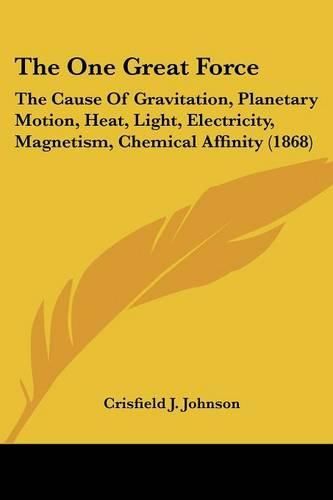Readings Newsletter
Become a Readings Member to make your shopping experience even easier.
Sign in or sign up for free!
You’re not far away from qualifying for FREE standard shipping within Australia
You’ve qualified for FREE standard shipping within Australia
The cart is loading…






Purchase of this book includes free trial access to www.million-books.com where you can read more than a million books for free. This is an OCR edition with typos. Excerpt from book: CHAPTER T. ELECTRICITY AND MAGNETISM. That electricity and heat are in some manner correlated, has long been evident. Each generates the other, but the precise connection between them has eluded the scrutiny of the most careful experimenters. The chief difference between them is that heat is diffused from its point of origin in every direction, and consequently with comparative moderation and evenness; while the characteristic of electricity is its intensity, its explosiveness, its tendency to act in channels or currents. If heat is simply the self-repulsive element, caloric, electricity is caloric confined in channels or bubbles. Air, undisturbed, is viewless and soundless; mixed in rapid motion with water and other elements, by means of friction or otherwise, it takes the form of bubbles, covered with a slight film, visible to the eye, and which burst with a perceptible noise at the slightest change of pressure. Electricity is an analogous result produced by the intermixture of caloric with other elements, usually by means of friction. The suddenness, whichis an element of all electrical phenomena, is thoroughly in unison with this idea of explosiveness. A small amount of electricity, too, is conducted thousands of miles through an iron wire; while it would require an enormous consumption of matter by combustion, to send light and heat to such a distance through the open medium of the atmosphere. If the iron is furnished with minute channels which confine the caloric, -and prevent its expending its force in a lateral direction, the reason of its producing far greater results in the shape of electricity than in that of heat, which radiates in every direction, is at once apparent. The action is almost precisely like that of powder in a gun barrel. If an ounce of powder be…
$9.00 standard shipping within Australia
FREE standard shipping within Australia for orders over $100.00
Express & International shipping calculated at checkout
Purchase of this book includes free trial access to www.million-books.com where you can read more than a million books for free. This is an OCR edition with typos. Excerpt from book: CHAPTER T. ELECTRICITY AND MAGNETISM. That electricity and heat are in some manner correlated, has long been evident. Each generates the other, but the precise connection between them has eluded the scrutiny of the most careful experimenters. The chief difference between them is that heat is diffused from its point of origin in every direction, and consequently with comparative moderation and evenness; while the characteristic of electricity is its intensity, its explosiveness, its tendency to act in channels or currents. If heat is simply the self-repulsive element, caloric, electricity is caloric confined in channels or bubbles. Air, undisturbed, is viewless and soundless; mixed in rapid motion with water and other elements, by means of friction or otherwise, it takes the form of bubbles, covered with a slight film, visible to the eye, and which burst with a perceptible noise at the slightest change of pressure. Electricity is an analogous result produced by the intermixture of caloric with other elements, usually by means of friction. The suddenness, whichis an element of all electrical phenomena, is thoroughly in unison with this idea of explosiveness. A small amount of electricity, too, is conducted thousands of miles through an iron wire; while it would require an enormous consumption of matter by combustion, to send light and heat to such a distance through the open medium of the atmosphere. If the iron is furnished with minute channels which confine the caloric, -and prevent its expending its force in a lateral direction, the reason of its producing far greater results in the shape of electricity than in that of heat, which radiates in every direction, is at once apparent. The action is almost precisely like that of powder in a gun barrel. If an ounce of powder be…